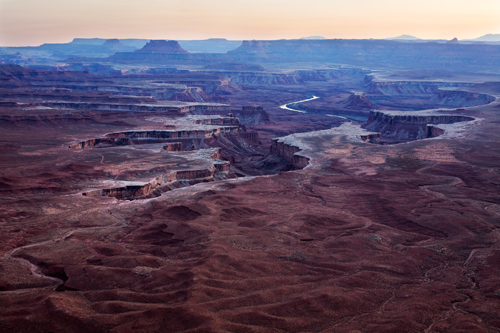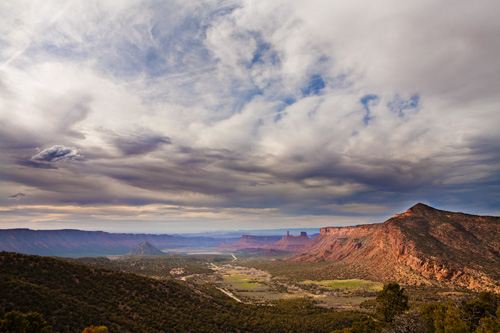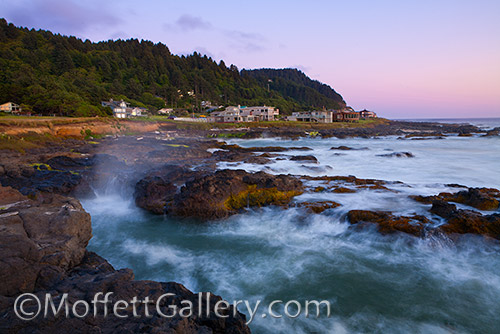by tmoffett | Mar 29, 2012 | Color, Photographic Philosophy, Photographic Technique

Green River Overlook
The weather in Moab, Utah has been crazy this week. Eighty degrees one day and then freezing cold and 20-30 mile per hour winds the next. The only thing we haven’t seen is storms. Some real storm clouds would be nice. I love photographing with good cloud formations in the sky. Even without the clouds, though, I have had a good time with my family and made a few good photographs as well.
We went to Canyonlands the other evening and stayed to watch the sunset. The sky was real hazy and the wind was whipping as a cold front was moving through, but it brought no real clouds. We drove through the Island in the Sky district and stopped to check out most of the access points to the rim of the canyon. We decided to go to the Green River Overlook area to see the sunset, and I am glad we did! The wind was howling, it was bitter cold and I left my coat at the hotel, there were dozens of photographers battling for prime real estate to shoot from, but the view was spectacular. I photographed until it was too dark to focus the camera and my fingers were too frozen to operate the camera anymore, then we all warmed up on the drive back to the hotel.
The image above is one that I made that night battling the wind and cold. When I got back and looked at the images, I noticed the cool undertones that most of the images had. Interesting for sunset photos, as they usually filled with predominately warm tones. It really showed me how much my own feelings influence how I photograph. I try to absorb my surroundings and make my photographic decisions based on feeling and emotion. This has become my way of working. Even when I am not thinking about it, that is often what happens. It did in Canyonlands that evening. I was working quickly and in a difficult environment, but my emotions took over. This was evident to me in the finished print. When we allow our work to become our way of life, our work becomes personal. That is what will take your work to a new level.
by tmoffett | Mar 26, 2012 | Color, Landscape, Ramblings

View from the La Sal Mountain Loop
My family is the most important thing in the world to me. Most all of my photography trips are combination trips where family time and photography time are combined. This trip is no different. Yesterday was a very laid back day. We attended church and then went for a Sunday Drive in the afternoon. I have been to Moab, Utah before, but spent most of my time at Arches National Park, so am really unfamiliar with the rest of what is here. We decided to explore. The weather was heavy overcast for most of the day, so the light was not very exciting, so not a great time for photography. We had a great time anyways, and at the same time found some great locations for when the light is better.
My wife and kids are the greatest! While I am sure they often get tired of me stopping to check out a view, then get out my gear even though the light is not perfect, or the wind is howling, or it’s cold outside, they never say a negative word. Sometimes they will get out and photograph with their point and shoot cameras, other times they will help me with my gear and at times just sit patiently in the truck. Sometimes I feel like I am selfish and do only what I want, and I probably am, but they never complain. I am totally blessed beyond measure.
I love photographing in locations that are not often photographed. I like trying to make the ordinary appear extraordinary. That was another reason for the drive yesterday. While we are near several National Parks that offer great views, they are also some of the most photographed locations in the world. It is very difficult to come up with my own personal images when I have been influenced by so many images already made in these places. I will spend some time in the National Parks, but will also spend time in other locations that draw my attention. I like finding my own “tripod holes,” so to speak.
The image above is one taken on the afternoon drive yesterday. It is a view toward the Moab Valley from the La Sal Mountains. We arrived at a clearing where we could see into the valley just as the sunlight broke through an opening in the clouds for only a minute. It was one of those times that I knew I had to make an image at that moment, because if I didn’t, the light would be gone, and it was. No time to change locations, just set up the best composition possible in about 30 seconds and shoot.
Ninety miles and five hours later we arrived back at the hotel. My seven year old was asleep, my thirteen year old stating, “I’m hungry,” and my wife still with a smile on her face. We ate supper, played some games and then off to bed. I love working vacations!
by tmoffett | Mar 23, 2012 | Color, Composition, Landscape, Photographic Philosophy

Clear Night, Arches National Park
It’s Spring Break here in Idaho, and time for another photography field trip! I’ll be photographing near Moab, Utah for the next few days and I am really looking forward to it. These kind of trips are very refreshing and help keep me fresh. It seems like a while since I have been out of my “Home Territory,” and will be a much needed break. I am a real advocate of photographing where you live, however an occasional road trip with the camera will do wonders for the revitalization of the soul.
In anticipation of this trip, I was reviewing some images made from a trip to Moab last summer. I came across this panorama that I shot at the end of the day when it was just about too dark to even focus the camera. That is one of my favorite times to shoot. It was a cloud free night and I found this horizon line to be quite interesting. It looked kind of like my lifeline, some ups and downs, maybe some bumps and bruises, yet constantly moving forward. I usually like a few good clouds, but this image, with its clean and simple design works just fine. God is the ultimate designer, and if we are observant enough, can find the beauty in whatever He places in front of us. That is the challenge. Find the beauty in the chaotic world in which we live. It is there. We must just simplify our vision in order to find it.
by tmoffett | Mar 21, 2012 | Color, Landscape, Photographic Philosophy, Photographic Technique

View From Ocean Drive, Yachats, OR
Photography means writing or drawing with light. Knowing this, it would then make sense that the better the light, the better the photograph. As simple as this concept may seem, it is sometimes hard to get students to understand it. So often I hear students in the process of researching other photographers work question why their own images don’t look more like the professionals. More often than not it comes down to light. You may be in a great location and have a great composition, but without great light you’ll end up with a mediocre photograph.
As the sun moves across the sky the color and quality of light that reaches the surface of the earth changes. The warm, soft light at sunrise turns to a cool and harsh light with deep shadows by mid-morning on a cloud-free summer day. By late evening the warm, soft light with rich, open shadows returns and slowly change to a soft cooler light after the sun sets. Coming to know these changes and learning to recognize what light quality will produce the mood and feeling that you want to elicit in your finished photograph are key to creating powerful images. For landscape photography, more often than not the early morning or late evening will produce the most desirable result.
There is one time of day that is often forgotten when it comes to making photographs; after the sun has set. I will often arrive at a location and watch as others are packing up and leaving and I am just getting started. A tripod is a must for making photos after sunset, but the mood and feeling rendered can be quite unlike anything that can be captured during the day. I will work many times until it is too dark to focus the camera.
The image above was taken just after sunset. You can see the warm pastel colors on the horizon, shifting to cooler tones in the upper sky. The warm light still on the horizon skims across the surface and illuminates the west face of the rocks and the buildings, while the cooler light from above illuminates the shadows and reflect off of the water. These subtle shifts in hue are what create some of the drama and interest in this image. Being patient and waiting for the right moment to press the shutter is much of what photography is about. Ansel Adams said, “Sometimes I do get to places just when God’s ready to have somebody click the shutter.” I believe that Ansel Adams had a very good understanding of light and placed himself at the right places and at the right times to take advantage of the beauty that God put in front of his lens.
by tmoffett | Mar 19, 2012 | Black and White, Landscape, Photographic Philosophy, Photographic Technique

Grape Leaves
One of the most frequently asked questions by students in my classroom while working on photographs in Photoshop is, “What should I do to this image?” Nearly always my reply is the same. “What did you see and feel when you photographed it?” This concept of visualizing the end result before pressing the shutter button on the camera is becoming a lost art, yet is so important to achieving consistent, meaningful and powerful results.
I began to understand the idea of previsualization while studying Ansel Adams zone system under the tutelage of Craig Law at Utah State University. When making exposures using the zone system, a photographer must first know what he/she wants because the exposure settings (aperture and shutter speed) and film development process is determined by what the finished print is to look like. The whole process is very calculated. One must slow down and think about the image that is about to be created. Some may claim that this attention paid to the technical details takes away from the spontaneous art of photography. I differ with this way of thinking. Slowing down, really looking and taking in a scene allows me the opportunity to feel my surroundings. I am able to focus on my emotions. What is it that caught my attention in the first place? Why do I feel I need to make a photograph? What do I really see? What emotion do I want to elicit in the viewer of the image I am about to make? These are just some of the questions that I ask myself while setting up to photograph a particular scene. Only after I have taken the time to experience the scene that I am about to photograph am I able to determine how best to replicate those emotions in a photograph. Once those decisions are made, there is no question as to how to process the image upon returning home. I have already experienced it!
Even though I now use advanced digital equipment instead of film for my photography, the principle of previsualization learned years ago is still prevalent in my methods of working. When out photographing, I first pay close attention to my emotional response to the scene in front of me. If I have no emotional response, the photograph will have no power. This determines whether or not I even take the camera out of the bag. After deciding that a scene is indeed worth photographing and what emotional response I want to evoke, I can then successfully determine the correct exposure settings, lens selection, white balance, ISO, etc. are necessary to convey my message. At the same time, processing and editing methods are determined as well.
All of this takes time and effort. By slowing down and thinking, even meditating while photographing, you too can learn to create more powerful images while actually making fewer exposures.







Recent Comments